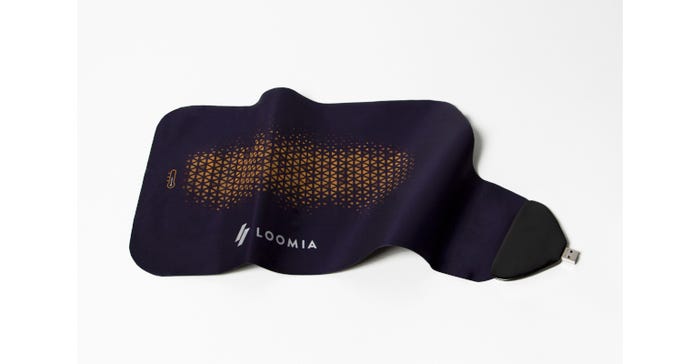The highly flexible mesh technology works especially well for flexible heating elements, pressure sensors, and sensor matrices.
August 30, 2022

Traditional FR4 PCBs and wires don't work for every application that needs electronics, especially not for those with soft surfaces. But even flexible PCBs and other flex circuits aren't always soft enough for some use cases.
The LOOMIA Electronic Layer (LEL) is used to make electronic textiles that conform easily to soft surfaces. It's more conformable than flex PCBs or other flex electronics and can combine multiple functions in a single circuit, said Madison Maxey, founder and CEO of LOOMIA Technologies, in an interview with Design News. The LEL's flexibility is similar to that of printed ink on thermoplastic polyurethane (TPU), although it's not printed.
The technology is especially suited for flexible heating elements as well as pressure sensors and matrices, said Maxey. Applications include heating and human-machine interfaces (HMIs) or "smart surfaces" in automotive. Others are end-effector sensing and cabling in robotics; several types of cabling, including in healthcare and wellness use cases such as wearables; in outdoor gear and sportswear; and for heating and lighting.
"As cabling, the LEL is generally used for wearable technology applications where you're trying to connect two sensors in a soft, flexible way," said Maxey. Garments made with the LEL can be configured to be sewn, washed, and even dried in a clothes dryer when optimized for robustness. Other LEL stackups can be optimized for lamination or lower cost.
Electronic Textiles for Car Seats and Robot Hands
A recent, widely publicized application for the LEL was heating the car seats in the AKXY2 concept car by Japanese materials firm Asahei Kasei Group. This car's design emphasizes sustainability in the automotive lifecycle to reduce its environmental impact, customer satisfaction such as pleasing appearance and physical comfort, and improving passenger safety. A third goal was to demonstrate the different benefits that cars bring to society, such as creating a mobile or stationary private space for individuals during pandemic-related lockdowns.

Surface heating has become important in considering the transition to electric vehicles, said Maxey in a statement, so LOOMIA worked with Asahei-Kasei to develop the LEL as a fast-heating seat component. In an earlier concept car by Hyundai, the LEL was custom designed for both heating and a user interface.
The LEL technology was also used in a 2020 project by famous robotics designer Festo. Thanks to this technology, the Bionic Mobile Assistant could be equipped with a hand that gives the robot a sense of touch, via LOOMIA's 113-point analog pressure matrix.
LOOMIA also designed and fabricated the robot hand's glove and delivered a fully integrated glove and sensor system that could be plugged directly into the robotic arm's control unit.
Coming Soon for Textiles
Exactly how the LEL works is proprietary, but Maxey did say it uses a mesh conductor, which provides low resistance, good mechanical stability, and more stress and strain without cracking, in other words, robustness not usually possible with printed ink on TPU.
The fact that it's not printed allows lower resistance conductors that don't easily change their resistance when stretched, according to the datasheet. Although the technology is not inherently stretchable, it can become stretchy when arranged in a serpentine geometry.

"In heating and lighting for outdoor gear, we're now developing a heated glove insert and heated sleeve to be used in highly tactile handwear for both commercial and military customers," Maxey said. "These will give users warmth and high dexterity in cold environments."
The company is also doing a lot of new work in automotive interiors, including smart surfaces and smart design for aesthetic purposes, like new seat designs, and functional purposes, like comfort, she said. "We're also working on some consumer products we can't discuss. But in many cases, our technology is an enabler."
About the Author(s)
You May Also Like



